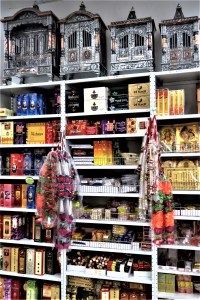by Tim Gilmore, 3/22/2017
Wearing glasses and a bright blue turban, Gurdev Singh stares right into my eyes, his face tilted slightly forward. It’s not his thick Punjabi accent that makes him difficult to understand so much as his softspokenness. He walks and speaks with a calm precision and gentle intensity.
“Good food is a good cultural ambassador,” he says.
When he and his brother Narinder opened India’s Restaurant in a strip mall on Baymeadows Road in 1997, they couldn’t have known that they’d lead much of Jacksonville’s Indian diaspora to settle in this once bland exurb. With seven Indian restaurants and groceries, even Indian dental offices, along a one mile stretch of Baymeadows Road, the area, originally so vanilla, today more closely resembles coriander and saffron.
Two decades ago, the Singh brothers chose Jacksonville, instead of Miami or Orlando, because the city lacked Indian cuisine. They chose Baymeadows for the same reasons many other Jacksonville transplants have: crime was low and the schools were good.
In a largely suburban town like Jacksonville, the inner rings of yesterday’s suburbia become “inner city,” while decades after “white flight,” the furthest suburban subdivisions are sometimes more ethnically diverse than hip urban neighborhoods.
When Jay Patel moved with his family to Jacksonville in 2005, he quickly discovered that more Indians lived in Baymeadows than any other part of town. So he opened Indian Grocery and Produce next door to India’s Restaurant.
Here, several customers, Indian and white, move along the stalls of fresh vegetables, shopping among eggplant, daikon, and ginger, beside large canvas bags of basmati and jasmine rice.
Jay had owned and operated a service station in New Jersey, but hated the weather. After staying a week in Jacksonville while visiting friends, he decided he was moving.
“The weather here is just like the weather where I’m from, in Gujarat,” he says. “I tell all my friends and family in New Jersey to come to Jacksonville. Five or six families that I knew up North have moved here now.”
Jay is slender, modest, with an unceasing friendly smile and the Hindu red dot or tilak, which corresponds to the Ajna or third-eye chakra.
Jacksonville’s Indian community reflects the diversity of India itself, recalling Gandhi’s famous statement that being Indian, he was Hindu, but “also a Muslim, a Christian, a Buddhist, and a Jew.”
The Singhs of India’s Restaurant are Sikhs from Punjab, a northern Indian state south of Kashmir and north of Delhi. Jay Patel is a Hindu from Gujarat, near Mumbai (Bombay). At Fifth Element, you can follow up Southern dishes like dosas, sometimes called Indian crepes with Northern Gajar ka Halwa, a sweet grated carrot dessert sautéed in ghee, a clarified butter. Apna Restaurant on Beach Boulevard offers a Muslim “Indian-Pakistani” cuisine that incorporates more meat, including beef, all of which is halal, meaning permissible according to religious dietary law, similar to kosher laws in Judaism.
Jay feels welcome in Jacksonville, attends temple here, and even celebrates the same festive days he did back in India, including Diwali, the autumn festival of lights, and Holi, the spring festival of colors. Holi celebrations are visually unforgettable, as participants cover each other in blue, green, orange, yellow and red powders obtained from springtime flowers and medicinal herbs.
Sandhya Hawaldar came to Jacksonville in 2003 for a tech job and fell in love with the weather and the beaches. Now president of the Indian Cultural Society of Jacksonville, she stresses the sociability of Indian culture and the fact that second generation Indian children know Jacksonville as their place of origin.
“Jacksonville is our home now. We love it as much we do our home in India, and our kids just think of Jacksonville as their only home,” she says.
Most of the Indians who have moved to Jacksonville are well educated, middle class, and upwardly mobile. Having, in addition, strong family and community support networks, they put very little pressure on the public welfare infrastructure. Unlike, say, Syrian war refugees, they have few needs for conservative monochromatic Americans to hold against them. Besides, there are different kinds of conservatism, and unlike rural Oceanway on the Northside, which for decades was Klan-conservative, Baymeadows, with its office parks and gated communities, is corporate-conservative.
Still, Jacksonville’s Indians haven’t been entirely free of Southern racism and xenophobia. When Gurdev Singh’s children were students at Twin Lakes Elementary, other students sometimes pushed them and called them racial slurs.
“When we complained to the principal, she said it happened in the cafeteria and she can’t control the cafeteria,” Singh says.
But even as the proto-fascist rhetoric of right wing politics stirs hate in the hearts of those who feel that America is no longer great because their own racial views have been marginalized, the best cure for anti-otherness has always been getting to know the people you perceive as other.
Jay Patel says, “Indian culture is very diverse. There are a billion people in India in 29 states. The Indian community in Jacksonville, Hindu or Sikh or Muslim, it’s very close, and we are all a part of Jacksonville too.”












